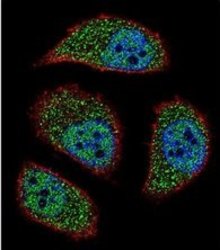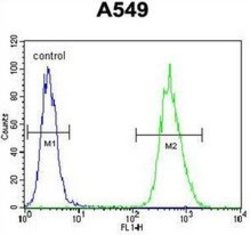Antibody data
- Antibody Data
- Antigen structure
- References [5]
- Comments [0]
- Validations
- Western blot [1]
- Immunocytochemistry [1]
- Immunohistochemistry [1]
- Flow cytometry [1]
Submit
Validation data
Reference
Comment
Report error
- Product number
- ABIN950671 - Provider product page

- Provider
- antibodies-online
- Product name
- anti-BCL2/adenovirus E1B 19kDa Interacting Protein 3-Like (BNIP3L) (AA 59-89), (Middle Region) antibody
- Antibody type
- Polyclonal
- Description
- Protein A column, followed by peptide affinity purification
- Reactivity
- Human
- Host
- Rabbit
- Epitope
- AA 59-89, Middle Region
- Vial size
- 0.4 mL
- Storage
- Store undiluted at 2-8°C for one month or (in aliquots) at -20°C for longer.
- Handling
- Avoid repeated freezing and thawing.
Submitted references Nix is a selective autophagy receptor for mitochondrial clearance.
Hypoxia-induced autophagy is mediated through hypoxia-inducible factor induction of BNIP3 and BNIP3L via their BH3 domains.
Hypoxia signals autophagy in tumor cells via AMPK activity, independent of HIF-1, BNIP3, and BNIP3L.
Polymorphisms in mitochondrial genes and prostate cancer risk.
Homozygous deletions and recurrent amplifications implicate new genes involved in prostate cancer.
Novak I, Kirkin V, McEwan DG, Zhang J, Wild P, Rozenknop A, Rogov V, Löhr F, Popovic D, Occhipinti A, Reichert AS, Terzic J, Dötsch V, Ney PA, Dikic I
EMBO reports 2010 Jan;11(1):45-51
EMBO reports 2010 Jan;11(1):45-51
Hypoxia-induced autophagy is mediated through hypoxia-inducible factor induction of BNIP3 and BNIP3L via their BH3 domains.
Bellot G, Garcia-Medina R, Gounon P, Chiche J, Roux D, Pouysségur J, Mazure NM
Molecular and cellular biology 2009 May;29(10):2570-81
Molecular and cellular biology 2009 May;29(10):2570-81
Hypoxia signals autophagy in tumor cells via AMPK activity, independent of HIF-1, BNIP3, and BNIP3L.
Papandreou I, Lim AL, Laderoute K, Denko NC
Cell death and differentiation 2008 Oct;15(10):1572-81
Cell death and differentiation 2008 Oct;15(10):1572-81
Polymorphisms in mitochondrial genes and prostate cancer risk.
Wang L, McDonnell SK, Hebbring SJ, Cunningham JM, St Sauver J, Cerhan JR, Isaya G, Schaid DJ, Thibodeau SN
Cancer epidemiology, biomarkers & prevention : a publication of the American Association for Cancer Research, cosponsored by the American Society of Preventive Oncology 2008 Dec;17(12):3558-66
Cancer epidemiology, biomarkers & prevention : a publication of the American Association for Cancer Research, cosponsored by the American Society of Preventive Oncology 2008 Dec;17(12):3558-66
Homozygous deletions and recurrent amplifications implicate new genes involved in prostate cancer.
Liu W, Xie CC, Zhu Y, Li T, Sun J, Cheng Y, Ewing CM, Dalrymple S, Turner AR, Sun J, Isaacs JT, Chang BL, Zheng SL, Isaacs WB, Xu J
Neoplasia (New York, N.Y.) 2008 Aug;10(8):897-907
Neoplasia (New York, N.Y.) 2008 Aug;10(8):897-907
No comments: Submit comment
Supportive validation
- Submitted by
- antibodies-online (provider)
- Main image

- Experimental details
- WB
Supportive validation
- Submitted by
- antibodies-online (provider)
- Main image

- Experimental details
- Confocal immunofluorescent analysis of BNIP3L / BNIP3A Antibody (Center) Cat.-No AP52881PU-N with A549 cell followed by Alexa Fluor®488-conjugated goat anti-rabbit lgG (green). Actin filaments have been labeled with Alexa Fluor 555 phalloidin (red). DAPI was used to stain the cell nuclear (blue).
Supportive validation
- Submitted by
- antibodies-online (provider)
- Main image

- Experimental details
- IHC
Supportive validation
- Submitted by
- antibodies-online (provider)
- Main image

- Experimental details
- FACS
 Explore
Explore Validate
Validate Learn
Learn Western blot
Western blot